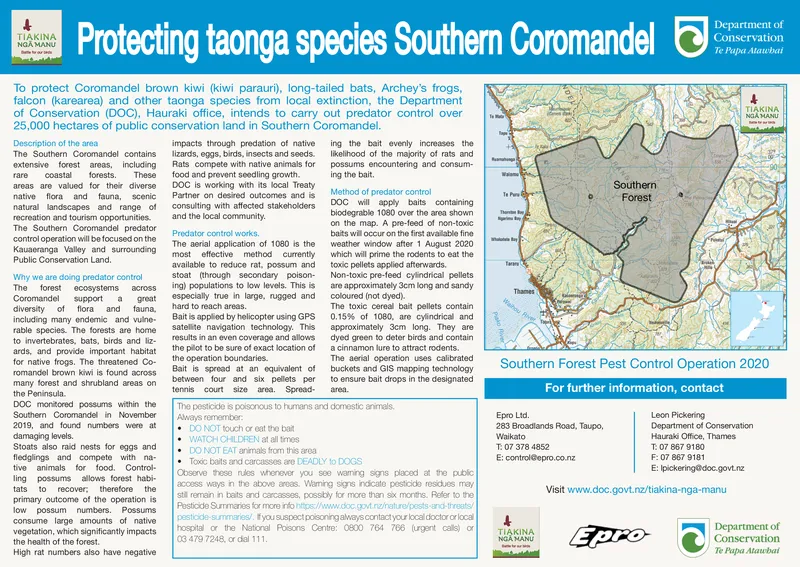Advertisement

-
Published Date
July 17, 2020This ad was originally published on this date and may contain an offer that is no longer valid. To learn more about this business and its most recent offers, click here.
Ad Text
Protecting taonga species Southern Coromandel E Department of Conservation TIAKINA NGA MANU Te Papa Atawbai To protect Coromandel brown kiwi (kiwi parauri), long-tailed bats, Archey's frogs, falcon (karearea) and other taonga species from local extinction, the Department of Conservation (DOC), Hauraki office, intends to carry out predator control over 25,000 hectares of public conservation land in Southern Coromandel. TIAKINA NGA HANU Description of the area The Southern Coromandel contains impacts through predation of native lizards, eggs, birds, insects and seeds. Rats compete with native animals for food and prevent seedling growth. DOC is working with its local Treaty Partner on desired outcomes and is ing the bait evenly increases the likelihood of the majority of rats and possums encountering and consum- ing the bait. extensive forest areas, including These rare coastal forests. Walan areas are valued for their diverse and Southern Forest Method of predator control DOC will apply baits containing biodegrable 1080 over the area shown on the map. A pre-feed of non-toxic baits will occur on the first available fine native flora fauna, scenic Te P consulting with affected stakeholders and the local community. natural landscapes and range of recreation and tourism opportunities. The Southern Coromandel predator control operation will be focused on the Kauaeranga Valley and surrounding Predator control works. The aerial application of 1080 is the effective method currently available to reduce rat, possum and stoat (through secondary poison- ing) populations to low levels. This is especially true in large, rugged and weather window after 1 August 2020 which will prime the rodents to eat the toxic pellets applied afterwards. Non-toxic pre-feed cylindrical pellets are approximately 3cm long and sandy coloured (not dyed). The toxic cereal bait pellets contain 0.15% of 1080, are cylindrical and approximately 3cm long. They are dyed green to deter birds and contain a cinnamon lure to attract rodents. most Public Conservation Land. Tara Why we are doing predator control The forest ecosystems across Thames Coromandel support a great Wahou hard to reach areas. diversity of flora including many endemic and vulne- rable species. The forests are home and fauna. Bait is applied by helicopter using GPS satelite navigation technology. This results in an even coverage and allows the pilot to be sure of exact location of the operation boundaries. Bait is spread at an equivalent of between four and six pellets per tennis court size area. Spread- to invertebrates, bats, birds and liz- ards, and provide important habitat for native frogs. The threatened Co- romandel brown kiwi is found across The aerial operation uses calibrated buckets and GIS mapping technology to ensure bait drops in the designated Southern Forest Pest Control Operation 2020 many forest and shrubland areas on the Peninsula. For further information, contact area. DOC monitored possums within the Southern Coromandel in November The pesticide is poisonous to huans and domestic animals. Always remember: DO NOT touch or oat the bat WATCH CHLDREN at all times DO NOT EAT animals from this area Epro Ltd. 283 Broadlands Road, Taupo, Waikato Leon Pickering Department of Conservation Hauraki Office, Thames T: 07 867 9180 2019, and found numbers were at damaging levels. Stoats also raid nests for eggs and fledglings and compete with na- tive animals for food. Control- T: 07 378 4852 E: control@epro.co.nz F: 07 867 9181 Toxic baits and carcasses are DEADLY 10 DOGS E: Ipickeringedoc.govt.nz Observe these rules whenever you see waning signs placed at the publc access ways in the above areas. Waming signs indicate pesticide residues may stil remain in bats and carcasses, possbly for more than six moniths. Refer to the Pesticide Summaries for more info https://www.cdoc.govt.rz/rature/pests-and-threats/ pesticde-summaries/. fyou suspectpoisoningalways contactyour local doctor orlocal hospital or the National Poisons Centre: 0800 764 766 (gent cals) or 03 479 7248, or dal 111. ling possums allows forest habi- therefore tats Visit www.doc.govt.nz/tiakina-nga-manu to recover; the primary outcome of the operation is low possum numbers. consume large amounts of native vegetation, which significantly impacts Possums Epro Department of Conservation TIAKINA NGA MANU the health of the forest. High rat numbers also have negative Te Papa Atawbal Pako A Protecting taonga species Southern Coromandel E Department of Conservation TIAKINA NGA MANU Te Papa Atawbai To protect Coromandel brown kiwi (kiwi parauri), long-tailed bats, Archey's frogs, falcon (karearea) and other taonga species from local extinction, the Department of Conservation (DOC), Hauraki office, intends to carry out predator control over 25,000 hectares of public conservation land in Southern Coromandel. TIAKINA NGA HANU Description of the area The Southern Coromandel contains impacts through predation of native lizards, eggs, birds, insects and seeds. Rats compete with native animals for food and prevent seedling growth. DOC is working with its local Treaty Partner on desired outcomes and is ing the bait evenly increases the likelihood of the majority of rats and possums encountering and consum- ing the bait. extensive forest areas, including These rare coastal forests. Walan areas are valued for their diverse and Southern Forest Method of predator control DOC will apply baits containing biodegrable 1080 over the area shown on the map. A pre-feed of non-toxic baits will occur on the first available fine native flora fauna, scenic Te P consulting with affected stakeholders and the local community. natural landscapes and range of recreation and tourism opportunities. The Southern Coromandel predator control operation will be focused on the Kauaeranga Valley and surrounding Predator control works. The aerial application of 1080 is the effective method currently available to reduce rat, possum and stoat (through secondary poison- ing) populations to low levels. This is especially true in large, rugged and weather window after 1 August 2020 which will prime the rodents to eat the toxic pellets applied afterwards. Non-toxic pre-feed cylindrical pellets are approximately 3cm long and sandy coloured (not dyed). The toxic cereal bait pellets contain 0.15% of 1080, are cylindrical and approximately 3cm long. They are dyed green to deter birds and contain a cinnamon lure to attract rodents. most Public Conservation Land. Tara Why we are doing predator control The forest ecosystems across Thames Coromandel support a great Wahou hard to reach areas. diversity of flora including many endemic and vulne- rable species. The forests are home and fauna. Bait is applied by helicopter using GPS satelite navigation technology. This results in an even coverage and allows the pilot to be sure of exact location of the operation boundaries. Bait is spread at an equivalent of between four and six pellets per tennis court size area. Spread- to invertebrates, bats, birds and liz- ards, and provide important habitat for native frogs. The threatened Co- romandel brown kiwi is found across The aerial operation uses calibrated buckets and GIS mapping technology to ensure bait drops in the designated Southern Forest Pest Control Operation 2020 many forest and shrubland areas on the Peninsula. For further information, contact area. DOC monitored possums within the Southern Coromandel in November The pesticide is poisonous to huans and domestic animals. Always remember: DO NOT touch or oat the bat WATCH CHLDREN at all times DO NOT EAT animals from this area Epro Ltd. 283 Broadlands Road, Taupo, Waikato Leon Pickering Department of Conservation Hauraki Office, Thames T: 07 867 9180 2019, and found numbers were at damaging levels. Stoats also raid nests for eggs and fledglings and compete with na- tive animals for food. Control- T: 07 378 4852 E: control@epro.co.nz F: 07 867 9181 Toxic baits and carcasses are DEADLY 10 DOGS E: Ipickeringedoc.govt.nz Observe these rules whenever you see waning signs placed at the publc access ways in the above areas. Waming signs indicate pesticide residues may stil remain in bats and carcasses, possbly for more than six moniths. Refer to the Pesticide Summaries for more info https://www.cdoc.govt.rz/rature/pests-and-threats/ pesticde-summaries/. fyou suspectpoisoningalways contactyour local doctor orlocal hospital or the National Poisons Centre: 0800 764 766 (gent cals) or 03 479 7248, or dal 111. ling possums allows forest habi- therefore tats Visit www.doc.govt.nz/tiakina-nga-manu to recover; the primary outcome of the operation is low possum numbers. consume large amounts of native vegetation, which significantly impacts Possums Epro Department of Conservation TIAKINA NGA MANU the health of the forest. High rat numbers also have negative Te Papa Atawbal Pako A
